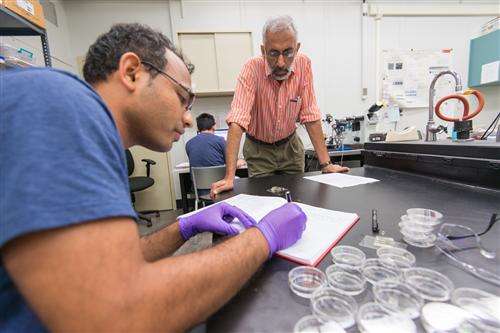Rethinking surface tension

(Phys.org) —If you've ever watched a drop of water form into a bead or a water strider scoot across a pond, you are familiar with a property of liquids called surface tension.
The interior molecules of a liquid are pushed and pulled by neighboring molecules in every direction, but those at the surface have only half as many neighbors to interact with. The resulting density change of molecules arranged near the surface causes a drop of water to form a sphere and prevents the insect from sinking even though its density is greater than the water's.
The surface tension of liquids is well-established, says Anand Jagota, but the same property in solid materials has seemed a moot point. Technically, it exists, but its force is usually too weak to deform a solid by more than an angstrom.
Jagota, professor of chemical engineering and director of Lehigh's bioengineering program, has pondered for more than a decade the possibility that some solids, especially soft biomaterials and geometrically altered materials, might also exhibit surface tension.
Over the last two years, at the Leibniz Institute for New Materials (INM) in Saarbruecken, Germany, and then at Cornell University, Jagota and his collaborators have experimented with two classes of solids: rubber-like elastomers and a more compliant gelatin similar in stiffness to human tissue.
A faithful, but attenuated replica
The researchers patterned the elastomer with ripples measuring microns in depth and then covered it with a gel and exposed it to air. Dark-field optical microscopy of a cross-section of the elastomer and gel revealed that the gel faithfully replicated the surface topography of the elastomer.
When the researchers removed the gel from the elastomer, however, the gel flattened almost instantaneously. It continued to match the peaks and valleys of the elastomer's ripples, but with significantly diminished features.
"We wondered if the gel would be an exact replica of the elastomer when we removed it," he says. "Instead, we saw an attenuated replica. The gel had filled all the undulations in the elastomer, but as soon as we removed it, a pent-up force acted immediately to flatten it."
The group reported their results in Physical Review E in an article titled "Surface-tension-induced flattening of a nearly plane elastic solid." Jagota's coauthors were Animangsu Ghatak '03 Ph.D., associate professor of chemical engineering at the Indian Institute of Technology at Kanpur, and Dadhichi Paretkar, formerly of INM and now a postdoctoral research associate at Lehigh.
"Our results show that surface tension of soft solids drives significant deformation, and that the latter can be used to determine the former," the researchers wrote.
"A basic mechanical force"
The discovery, says Jagota, should motivate scientists and engineers to rethink many of their assumptions.
"It has generally been agreed that surface tension in solids was felt only at the atomic scale. We have shown that surface tension in these compliant solids is a real thing and that it manifests itself at relatively large scales.
"As a basic mechanical force, surface tension in compliant solids will play a role in all mechanical phenomena involving compliant materials, especially biomaterials. How do things fracture, stick, slide, have friction, deform? What are the elastic forces that resist a cell when it spreads on a gel? How strongly do dust particles stick to the inside of a lung?
"We're going to have to rethink many of the questions involving compliant materials."
After experimenting on the elastomer and gel, Jagota asked a second question: Could surface tension be observed in a stiff material made compliant by geometry, such as a thin sheet of paper?
From an elastomeric material, Jagota and his colleagues made an annulus, or ring-shaped object. Across its hole, they suspended a thin film of the same material and deposited a 1-mm drop of water on top of the film. As expected, the drop beaded on the elastomer.
"When we placed the drop of water on the bottom of the thin film," says Jagota, "the drop bulged up. This was counterintuitive, as it bulged in an opposite direction to gravitational pull.
"We expected to see a sagging as the water drop beaded. Instead, it appeared to defy gravity. The explanation for this is surface tension."
The researchers, Jagota says, had replicated the phenomenon of Neumann's triangle, which describes the surface tensions of three immiscible liquids—such as an oil, water and a hydrophobic liquid that doesn't mix with oil—that are in equilibrium.
"In our case, we replaced one of the three liquids with a solid—the thin film elastomer—which behaved like the third liquid in Neumann's triangle."
The group published their results in the Proceedings of the National Academy of Sciences. Their article, titled "Solid surface tension measured by a liquid drop under a solid film," was coauthored by Jagota; Nichole Nadermann, former research scientist at Lehigh and now a postdoctoral fellow at the National Institute for Standards and Technology; and Chung-Yuen Hui, professor of mechanical and aerospace engineering at Cornell.
Journal information: Physical Review E , Proceedings of the National Academy of Sciences
Provided by Lehigh University



















